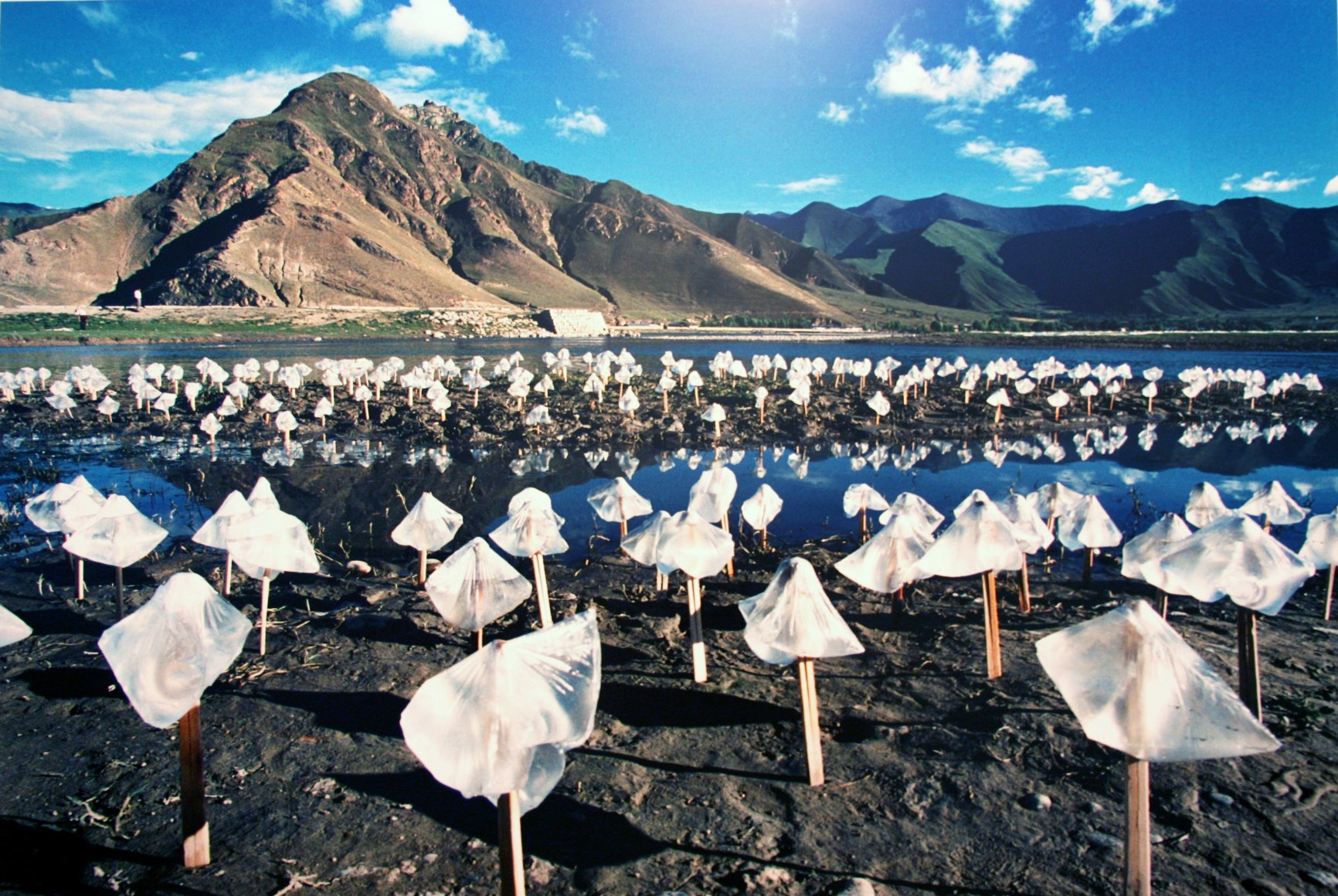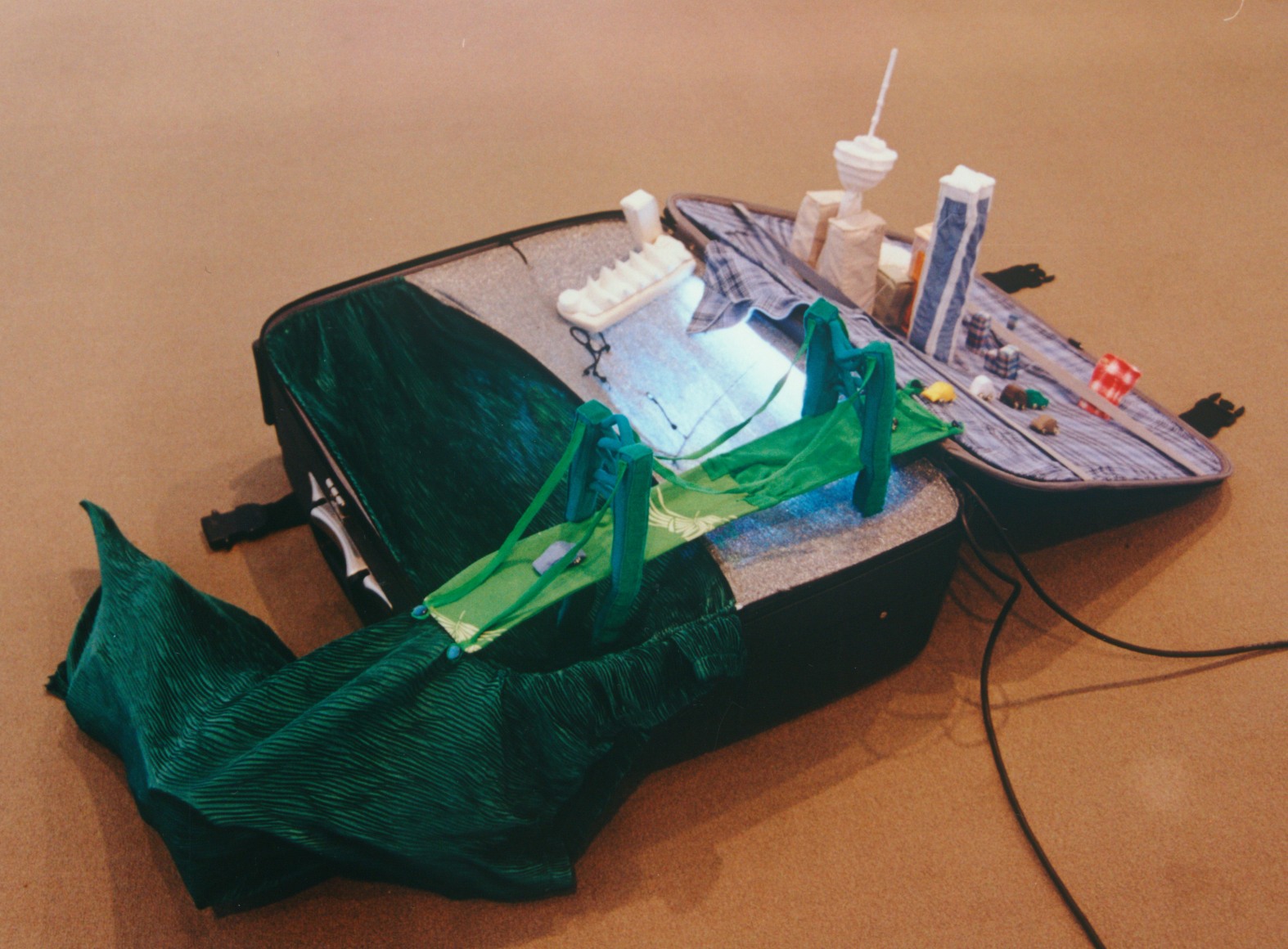Chambers Fine Art Beijing is pleased to announce the opening of Yin Xiuzhen – Works 1994 – 2008.
Born in Beijing in 1963, Yin Xiuzhen graduated in painting from Capital Normal University in 1989 but turned to installation in 1994. She has since become one of China’s leading sculptor/installation artists and represented China at the Venice Biennale in 2007. As a native of Beijing she felt strongly not only about the destruction of the old city that began with the Old and Dilapidated Housing Renewal Program implemented under the auspices of the Beijing Municipal Government in 1990 but also about ecological issues at a time when there were was little awareness of their seriousness. Her concern with these large issues, however, emerged not in polemical statements but in highly personal works frequently incorporating discarded clothes and shoes or roof tiles from houses that had recently been demolished.
Pear Tree, 1994 and Harp, 1995 document poetic interventions made in the countryside, just outside Beijing for the former and in Europe for the latter. In Pear Tree a network of threads linked by china bowls full of water sunk into the earth indicates the roots beneath the surface, emphasizing the links between the spreading branches of the tree above ground and the root system that depends on water to convey nutrients from the soil. The strangely shaped trunk of the tree in Harp required only the addition of a series of strings to convert it into a temporary musical instrument, an Aeolian harp “played” by the wind.
For Washing the River, 1995, and Living Water, 1996 she moved further afield, to Chengdu in South West China for the former and the banks of the Lhasa River outside Lhasa for the latter. In 1995 she was invited to take part in the “Healing the Waters Project” of the American artist Betsy Damon. Washing the River was her contribution. Shocked at the polluted state of the Funan River, she froze ten cubic meters of the foul water into large blocks and then invited passers by to wash it clean, an act heavy in symbolism that finds parallels in the rituals of baptism in western society. The Lhasa River inspired a different response, in keeping with the pristine setting outside the capital city. In Living Water two thousand pairs of chopsticks sunk into the muddy river banks support plastic bags filled with clear water, an affirmation of the crucial importance of clean water in all societies, rich and poor.
Roof Tiles, 1998, belongs to the series of works in which Yin Xiuzhen responded to the destruction of the old Beijing she knew as a young girl. Resigned to the inevitable yet determined to record the extinction of the hutongs (lanes) and siheyuans (courtyards) that were being demolished, she collected roof tiles and other elements from the debris and utilized them in a series of works beginning with Ruined City in 1996. Bearing photographs of aspects of Beijing life that were about to disappear, the neatly arranged tiles spread out to dry on the roof in Roof Tiles recalled a time when life in Beijing was gentler and slower paced. There is an element of nostalgia, also in the cotton shoes used in the 1998 installation Yin Xiuzhen, used as containers for photographs of Yin Xiuzhen from the age of one to thirty-five.
Suitcases
“When I began this series, I was constantly traveling. I saw the baggage conveyor at the baggage claim every time I traveled. Many people waited there. I was one of them. Since I always traveled with a huge suitcase, it felt like I was traveling with my home.” Yin Xiuzhen
As Yin Xiuzhen’s career gained momentum in the 1990s, she spent an increasing amount of time on the road, participating in international exhibitions, taking up residencies etc. Many of her earlier works incorporated used clothes, her own as well as those of her immediate family, and it is no surprise perhaps that she turned to the suitcase as container initially for portraits of cities and more recently of individuals. Beginning with Beijing in 2001, the city with which she was most familiar, she turned to Shanghai and Berlin the following year. Using luggage that has already been compromised by extensive travels and handling in baggage claim areas and old clothes that have been gathered on site, she constructs portraits of cities throughout the world that may or may not depend on famous landmarks for identification. Portable Cities: Vancouver, 2003 constructs a visual and audio portrait of the city from used clothes, a city map, and audio equipment. While Marcel Duchamp’s Boite-en valise is a traveling museum of 69 works by Duchamp, Yin Xiuzhen’s suitcases are traveling containers of highly specific references to cities throughout the world, identified to a greater or lesser degree by labels, luggage tags that document their travels prior to becoming works of art.
Even more personal are Suitcase Biography: CWM, 2006 and Suitcase Biography: JLT, 2008, portraits of individuals assembled from old suitcases and clothes dating from different periods of their lives fashioned into miniature replicas of monuments that symbolize cities where they have lived. In the CWM suitcase which accompanied the owner to the USA when he first arrived from China in the 1980s, the Wuhan Yangtze River Bridge and the Brooklyn Bridge emerge from a patchwork of designer labels. The monochromatic JLT suitcase follows the owner from London Bridge to the Chelsea Hotel, the Benjamin Franklin Bridge between Camden and Philadelphia and the Empire State Building. Although not visible, passports and other travel documents contained inside provide supplementary information on the life of the anonymous “sitter” for the portrait.
Yin Xiuzhen and Song Dong
Yin Xiuzhen is married to Song Dong. Before 2002 their careers had developed independently but in that year they worked together for the first time in the exhibition Chopsticks at Chambers Fine Art. A pair of chopsticks came to symbolize their mutual trust and understanding as a married couple.
Three works in the current exhibition are joint productions. Dating from 2002 is Beijing 360 Degrees which represents Song Dong and a heavily pregnant Yin Xiuzhen surveying Beijing from the top of Jingshan Mountain, once the highest point of the imperial capital. During their residency at the Asian Cultural Council in New York in 2006 the artists filmed each other’s hands in the video Left Hand, Right Hand. World – Cross –section of a chopstick, 2008 juxtaposes Song Dong’s shining surface which reflects the viewer in the surrounding environment with Yin Xiuzhen’s fabric race-track made from her signature old clothes. They complement each other at the same time as they are in complete contrast.



